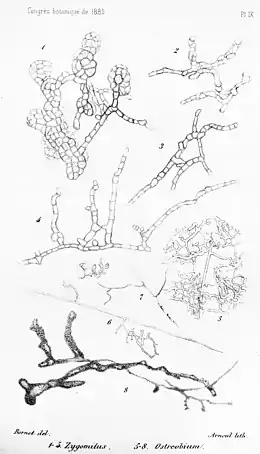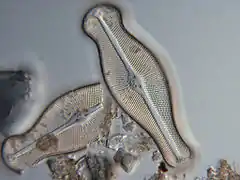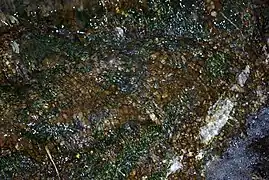| Part of a series related to |
| Benthic life |
|---|
 |
|
Benthos Benthic zone Benthopelagic (coupling) Seabed |

Phytobenthos (/.faɪtoʊˈbɛnθɒs/) (from Greek φυτόν (phyton, meaning "plants") and βένθος (benthos, meaning "depths") are autotrophic organisms found attached to bottom surfaces aquatic environments, such as rocks, sediments, or even other organisms.[1][2][3] This photosynthetic community includes single-celled or filamentous cyanobacteria, microalgae, and macrophytes.[4][5] Phytobenthos are highly diverse, and can be found in freshwater and marine environments, as well as transitional water systems.[6][7] However, their distribution and availability still depend on the factors and stressors that exist in the environment.[8] Because phytobenthos are autotrophs, they need to be able to subsist where it is still possible to perform photosynthesis.[1] Similar to phytoplankton, phytobenthos contribute to the aquatic food web for grazers and heterotrophic bacteria, and researchers have also been studying their health as an indicator for water quality and environmental integrity of aquatic ecosystems.[5][9][10][11][12][13]
Overview

Phytobenthos are subcategorized into microphytobenthos and macrophytobenthos. Microphytobenthos such as diatoms can be as small as 0.2 μm in diameter, and macrophytobenthos such as kelps can be tens of meters long.[4][14] To establish themselves on surfaces, phytobenthos usually stabilize themselves onto substrates through the use of various polysaccharides, glycoproteins, and even lipids that make up the extracellular polymeric substance, of which 40 - 90% of the carbons are derived from carbohydrates.[15] Some species of phytobenthos such as Ostreobium and diatoms such as the Synedra acus Kütznig have been observed to live in a free-living state.[16][17] Benthic diatoms have been found to be useful indicator species for determining the state of the aquatic environment as many study models have demonstrated association between the type of diatom communities that are present and the stability and the size of the sediments.[18] Non-diatom phytobenthos such as the cyanobacteria Nostoc spp. and Phormidium spp. have also been used as biological indicators.[19]
Diversity
Phytobenthos consist of both eukaryotic and prokaryotic communities, which can be identified by using microscopy or by performing gene sequencing with 16S rRNA (for prokaryotes) and 18S rRNA (for eukaryotes).[20] The eukaryotic communities of phytobenthos include microalgae such as Chlorophyceae, Bacillariophyceae, Cryptophyceae, and Chrysophyceae.[21] In the marine environment, some additional representative populations include Rhodophyta, which has been reportedly found in intertidal regions.[22] The prokaryotic communities of phytobenthos are composed primarily of filamentous cyanobacteria, some of which have been identified to be capable of producing hepatotoxins.[23]
Habitats

Depending on the type of substrates to which the phytobenthos is attached, they would be considered as epilithic (growing on rocks and other manmade, artificial substances), epipelic (growing on silt), episammic (growing on sand), epiphytic (growing on other plants), or epizoic (growing on animals).[24] Epizoic phytobenthos such as Ostreobium and Symbiodinium have also been found to grow on skeletons or within corals to which they have established symbiotic relationships by exchanging nutrients.[25]
The phytobenthos' habitats can range from freshwater systems such as rivers and lakes to coastal regions. In the marine environment, phytobenthos can be found as far back from the shore as the subtidal zones where they are consistently submerged in water.[26] Their productivity does not extend beyond the outer boundary of the littoral zones, the region to which sunlight can still penetrate to the bottom.[27]
With increasing depth, there is a decline in algal cover due in part to light availability.[1][3] In addition to depth, turbidity can restrict the extent of light availability, which would also impact the extent of phytobenthic growth.[1][28] However, phytobenthos such as Ostreobium have demonstrated capability to adapt to low-light conditions as grow in areas as deep as 200 meters.[3][25] Some diatoms also demonstrated mobility and rise to the surface during the earlier part of the year.[24]
Other physical and chemical conditions that also determine phytobenthos distributions include flow, acidity, nutrient, temperature, and the community's composition.[1] Water flow can determine the types and distributions of phytobenthos, especially in the stream communities where the water is constantly moving.[1] Rivers with more steady flow contribute to the stable environment that can promote the growth of phytobenthos communities.[29]
Ecology
Phytobenthos form biofilm with other microbial populations, including heterotrophic bacteria, which can also produce extracellular polymeric substance to help establish biofilm.[20] Within these diverse communities, phytobenthos sustains the heterotrophs and mixotrophs not only by serving as food themselves.[20] Phytobenthos can fix organic matters as primary producers, and the extracellular polymeric substance they produced to attach themselves to surfaces can also be utilized by bacteria as another potential carbon source.[15] The presence of consumers are not the only biotic factors driving changes to the phytobenthos composition in the community. Photosynthetic populations that demonstrate themselves to be competitive can also change the benthic community makeup.[30] The diatom D. geminata can proliferate quickly and are readily adaptive to changes to the aquatic environment.[30]
Researchers have assigned trophic values or indicators based on the Periphyton Index of Trophic status (PIT) to phytobenthos as another means to determine the ecological status of water bodies.[10][11] Researchers have also taken into consideration of the water chemistry, richness of the community, and biomass in their studies.[10] Depending on the site of study, researchers also account for the activities from the phytobenthos when calculating for primary productivity.[31]

 Didymosphenia geminata coverage of stream bed
Didymosphenia geminata coverage of stream bed
References
- 1 2 3 4 5 6 Law, Rosemary J. (December 2011). "A Review of the Function and uses of, and Factors Affecting, Stream Phytobenthos". Freshwater Reviews. 4 (2): 135–166. doi:10.1608/FRJ-4.1.448. ISSN 1755-084X. S2CID 89974491.
- ↑ Mora, Demetrio; Jung, Lea (2021-02-04). "Exploring new territories: sampling phytobenthos in large rivers". International Society for Diatom Research. Retrieved 2021-11-13.
- 1 2 3 Aponte, Nilda E.; Ballantine, David L. (October 2001). "Depth distribution of algal species on the deep insular fore reef at Lee Stocking Island, Bahamas". Deep Sea Research Part I: Oceanographic Research Papers. 48 (10): 2185–2194. Bibcode:2001DSRI...48.2185A. doi:10.1016/S0967-0637(01)00011-5.
- 1 2 Wilkinson, M. (2001), "Phytobenthos", Encyclopedia of Ocean Sciences, Elsevier, pp. 2172–2179, doi:10.1006/rwos.2001.0216, ISBN 978-0-12-227430-5, retrieved 2021-11-14
- 1 2 Schaumburg, Jochen; Schranz, Christine; Foerster, Julia; Gutowski, Antje; Hofmann, Gabriele; Meilinger, Petra; Schneider, Susanne; Schmedtje, Ursula (December 2004). "Ecological classification of macrophytes and phytobenthos for rivers in Germany according to the water framework directive". Limnologica. 34 (4): 283–301. doi:10.1016/s0075-9511(04)80002-1. ISSN 0075-9511.
- ↑ Urbanič, Gorazd; Debeljak, Barbara; Kuhar, Urška; Germ, Mateja; Gaberščik, Alenka (2021-06-30). "Responses of Freshwater Diatoms and Macrophytes Rely on the Stressor Gradient Length across the River Systems". Water. 13 (13): 1814. doi:10.3390/w13131814. ISSN 2073-4441.
- ↑ Petrocelli, Antonella; Cecere, Ester; Rubino, Fernando (2019-03-05). "Successions of phytobenthos species in a Mediterranean transitional water system: the importance of long term observations". Nature Conservation. 34: 217–246. doi:10.3897/natureconservation.34.30055. ISSN 1314-3301. S2CID 155161822.
- ↑ L'Abée-Lund, Jan Henning; Haugland, Svein; Melvold, Kjetil; Saltveit, Svein Jakob; Eie, Jon Arne; Hvidsten, Nils Arne; Pettersen, Vegard; Faugli, Per Einar; Jensen, Arne J. (2009-01-01), Tockner, Klement; Uehlinger, Urs; Robinson, Christopher T. (eds.), "Chapter 15 - Rivers of the Boreal Uplands", Rivers of Europe, London: Academic Press, pp. 577–606, ISBN 978-0-12-369449-2, retrieved 2021-11-14
- ↑ Kelly, Martyn (2013-11-01). "Data rich, information poor? Phytobenthos assessment and the Water Framework Directive". European Journal of Phycology. 48 (4): 437–450. doi:10.1080/09670262.2013.852694. ISSN 0967-0262. S2CID 84627104.
- 1 2 3 Schneider, Susanne C.; Hjermann, Dag O.; Edvardsen, Hanne (2019-05-01). "Do benthic algae provide important information over and above that provided by macrophytes and phytoplankton in lake status assessment? – Results from a case study in Norway". Limnologica. 76: 28–40. doi:10.1016/j.limno.2019.02.001. hdl:11250/2629019. ISSN 0075-9511. S2CID 109717021.
- 1 2 Schaumburg, Jochen; Schranz, Christine; Hofmann, Gabriele; Stelzer, Doris; Schneider, Susanne; Schmedtje, Ursula (2004-12-01). "Macrophytes and phytobenthos as indicators of ecological status in German lakes — a contribution to the implementation of the water framework directive". Limnologica. New methods for assessing freshwaters in Germany. 34 (4): 302–314. doi:10.1016/S0075-9511(04)80003-3. ISSN 0075-9511.
- ↑ Bohórquez, Julio; McGenity, Terry J.; Papaspyrou, Sokratis; García-Robledo, Emilio; Corzo, Alfonso; Underwood, Graham J. C. (2017). "Different Types of Diatom-Derived Extracellular Polymeric Substances Drive Changes in Heterotrophic Bacterial Communities from Intertidal Sediments". Frontiers in Microbiology. 8: 245. doi:10.3389/fmicb.2017.00245. ISSN 1664-302X. PMC 5326797. PMID 28289404.
- ↑ Bilous, Olena P.; Wojtal, Agata Z.; Ivanova, Natalia O.; Tsarenko, Petro M.; Burova, Olga V.; Barinova, Sophia (December 2020). "Benthic Diatom Composition in Coastal Zone of Black Sea, Sasyk Reservoir (Ukraine)". Diversity. 12 (12): 458. doi:10.3390/d12120458.
- ↑ "Kelp Forests - Oceans, Coasts & Seashores (U.S. National Park Service)". www.nps.gov. Retrieved 2021-11-14.
- 1 2 Bohórquez, Julio; McGenity, Terry J.; Papaspyrou, Sokratis; García-Robledo, Emilio; Corzo, Alfonso; Underwood, Graham J. C. (2017). "Different Types of Diatom-Derived Extracellular Polymeric Substances Drive Changes in Heterotrophic Bacterial Communities from Intertidal Sediments". Frontiers in Microbiology. 8: 245. doi:10.3389/fmicb.2017.00245. ISSN 1664-302X. PMC 5326797. PMID 28289404.
- ↑ Massé, A.; Tribollet, A.; Meziane, T.; Bourguet-Kondracki, M.L.; Yéprémian, C.; Sève, C.; Thiney, N.; Longeon, A.; Couté, A. (2020-09-19). "Functional diversity of microboring Ostreobium algae isolated from corals". doi:10.1101/2020.09.18.303545. S2CID 221823026. Retrieved 2021-11-14.
{{cite journal}}: Cite journal requires|journal=(help) - ↑ Vilbaste, Sirje (2001). "Benthic diatom communities in Estonian rivers" (PDF). Boreal Environment Research. 6: 191–203.
- ↑ Pan, Yangdong; Hill, Brian H.; Husby, Peter; Hall, Robert K.; Kaufmann, Philip R. (May 2006). "Relationships Between Environmental Variables and Benthic Diatom Assemblages in California Central Valley Streams (USA)". Hydrobiologia. 561 (1): 119–130. doi:10.1007/s10750-005-1609-z. ISSN 0018-8158. S2CID 12877155.
- ↑ Monteagudo, Laura; Moreno, José Luis (August 2016). "Benthic freshwater cyanobacteria as indicators of anthropogenic pressures". Ecological Indicators. 67: 693–702. doi:10.1016/j.ecolind.2016.03.035. ISSN 1470-160X.
- 1 2 3 Zancarini, Anouk; Echenique-Subiabre, Isidora; Debroas, Didier; Taïb, Najwa; Quiblier, Catherine; Humbert, Jean-François (2017-06-28). "Deciphering biodiversity and interactions between bacteria and microeukaryotes within epilithic biofilms from the Loue River, France". Scientific Reports. 7 (1): 4344. Bibcode:2017NatSR...7.4344Z. doi:10.1038/s41598-017-04016-w. ISSN 2045-2322. PMC 5489527. PMID 28659582.
- ↑ Dorigo, U.; Bérard, A.; Humbert, J.F. (2002-12-01). "Comparison of Eukaryotic Phytobenthic Community Composition in a Polluted River by Partial 18S rRNA Gene Cloning and Sequencing". Microbial Ecology. 44 (4): 372–380. doi:10.1007/s00248-002-2024-x. ISSN 0095-3628. PMID 12375097. S2CID 26068207.
- ↑ Moura, Carlos Wallace do Nascimento; Alves, Aigara Miranda; Santos, Alana Araújo dos; Almeida, Wellington Romualdo de Almeida; Moniz Brito, Kátia Lidiane; Oliveira, Ingryd Santana de; Freitas, Nelma Dos Santos; Oliveira, Ivania Batista de; Ramos, Geraldo José Peixoto (2015-08-04). "Checklist of phytobenthos from Boipeba Island, Bahia, Brazil, emphasizing the morphological features of Nitophyllum punctatum (Rhodophyta, Ceramiales)". Check List. 11 (4): 1704. doi:10.15560/11.4.1704. ISSN 1809-127X.
- ↑ Gaget, Virginie; Humpage, Andrew R.; Huang, Qiong; Monis, Paul; Brookes, Justin D. (2017-11-01). "Benthic cyanobacteria: A source of cylindrospermopsin and microcystin in Australian drinking water reservoirs". Water Research. 124: 454–464. doi:10.1016/j.watres.2017.07.073. ISSN 0043-1354. PMID 28787682.
- 1 2 The Freshwater algal flora of the British Isles: an identification guide to freshwater and terrestrial algae. 2003-02-01.
- 1 2 del Campo, Javier; Pombert, Jean-François; Šlapeta, Jan; Larkum, Anthony; Keeling, Patrick J. (January 2017). "The 'other' coral symbiont: Ostreobium diversity and distribution". The ISME Journal. 11 (1): 296–299. doi:10.1038/ismej.2016.101. ISSN 1751-7370. PMC 5315466. PMID 27420029.
- ↑ Longphuirt, SN; Leynaert, A; Guarini, JM; Chauvaud, L; Claquin, P; Herlory, O; Amice, E; Huonnic, P; Ragueneau, O (2006-12-20). "Discovery of microphytobenthos migration in the subtidal zone". Marine Ecology Progress Series. 328: 143–154. Bibcode:2006MEPS..328..143L. doi:10.3354/meps328143. ISSN 0171-8630.
- ↑ Boulion, V. V. (January 2004). "Contribution of Major Groups of Autotrophic Organisms to Primary Production of Water Bodies". Water Resources. 31 (1): 92–102. doi:10.1023/b:ware.0000013579.89883.55. ISSN 0097-8078. S2CID 129729257.
- ↑ Makovinska, Jarmila; Hlubikova, Dasa (2014), Liska, Igor (ed.), "Phytobenthos of the River Danube", The Danube River Basin, Berlin, Heidelberg: Springer Berlin Heidelberg, vol. 39, pp. 317–340, doi:10.1007/698_2014_310, ISBN 978-3-662-47738-0, retrieved 2021-11-14
- ↑ Lowe, Rex L. (1979), Ward, James V.; Stanford, Jack A. (eds.), "Phytobenthic Ecology and Regulated Streams", The Ecology of Regulated Streams, Boston, MA: Springer US, pp. 25–34, doi:10.1007/978-1-4684-8613-1_3, ISBN 978-1-4684-8615-5, retrieved 2021-11-14
- 1 2 Figueroa, Fabián; Pedreros, Pablo; Cruces, Fabiola; Abdala-Díaz, Roberto; Hernández, Víctor; Becerra, José; Urrutia, Roberto (2018-12-13). "Effect of Didymosphenia geminata coverage on the phytobenthic community in an Andean basin of Chile". Revista Chilena de Historia Natural. 91 (1): 10. doi:10.1186/s40693-018-0080-y. ISSN 0717-6317. S2CID 55554713.
- ↑ Webster, Ian T.; Ford, Phillip W.; Hodgson, Bruce (August 2002). "Microphytobenthos contribution to nutrient-phytoplankton dynamics in a shallow coastal lagoon". Estuaries. 25 (4): 540–551. doi:10.1007/bf02804889. ISSN 0160-8347. S2CID 84789607.